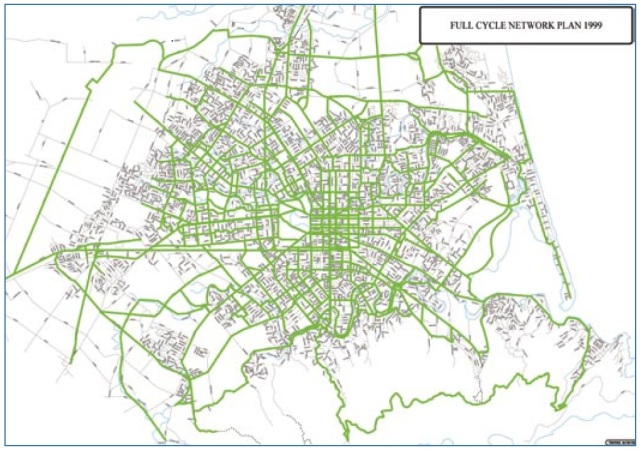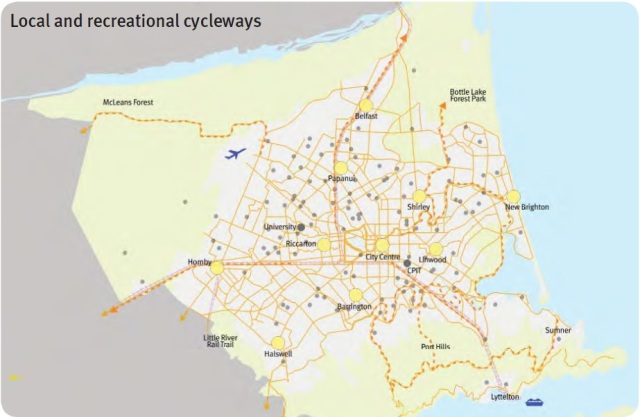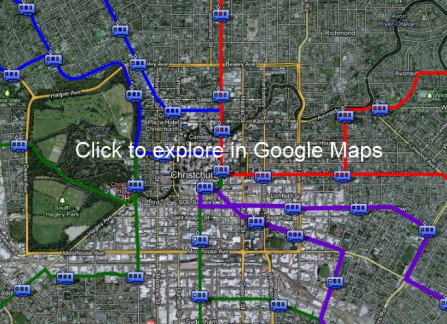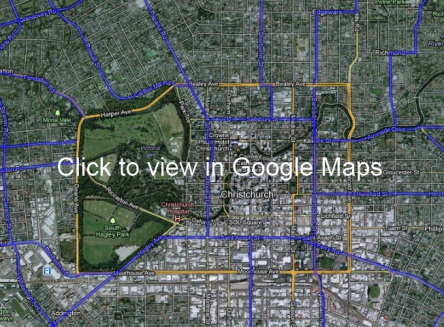Lately members of many online communities have co-operated together to develop all sorts of complex and useful programs despite the members being spread far and wide around the world. Should this online community be looking at co-operating to design our own preferred cycling infrastructure for Christchurch?
As the recent blog on this site discussing CERA’s Draft Central City Transport Plan pointed out, the suggested cycle routes in town didn’t appear to head out on the right routes to connect with a city wide network. Any submission that raised that point would have much more strength if it was backed up with a design for a suggested city-wide network along with suggested changes in the city centre to make it all fit together.
The Christchurch Cycling Strategy of 2004 contained a plan of routes devised in 1999 but in 2012 few of them are on the ground.

This year’s Christchurch Transport Plan contains a similar network plan but it appears to contain even more routes than in 2004.

I haven’t tried to work out the total length of all cycle routes on the latest plan but it looks far too extensive to fit within likely budgets or a reasonable time frame and runs the risk of going the same way as the 1999 plan.
If we were advocating for light rail rather than cycling we might co-operate to design a network looking something like this:

Before ending up with a design there would need to be some objectives such as:
- 90% of households within 800 metres of a stop
- Minimise transfers required for any trip
- Maximum travel time for any trip 45 minutes.
- Maximise resilience
What would be the objectives of a cycle network design? These are suggested as a basis for starting a design process and are not intended to rule out anyone else’s (probably better) criteria:
- Network to be mostly along arterial roads
- Separation to be provided by parked vehicles and/or physical barrier
- All controlled intersections to be up to the latest Dutch CROW standards
- Access to the network to be available from all households without crossing an arterial road which is not part of the network
With these criteria in mind we might get a network looking something like this:
Using these criteria we come out with a total network of around 240km. That doesn’t include existing off-road routes like Hagley Park and the Northern rail track which would link into the new network, nor does it allow for the latest central city proposals but it’s on a reasonable scale and could be completed in five to ten years.
Share An Idea brought out the enthusiasm and backing for better cycling facilities in Christchurch. How could we use modern Internet based technology to share ideas at a more detailed level and identify the kind of cycling network that would work for most people?


Thanks for your post Jim.Yes I definitely think that it is important to involve the community when designing a cycle network. The experts do not always get it right unfortunately and there is a wealth of knowledge and ideas to be found in the community. Consultation will mean some delays but this might be worth and Spokes 1000 day key cycling projects could already be started. Maybe the experts need to propose three or four network plans that are open for submission in a Share an Idea way. This blog is great for exchanging ideas and viewpoints and will further raise the quality of submissions! Any cycle plan should be made SMART (with Specific, Measurable, Attractive, Realistic and Time-framed objectives) so that glossy pictures become reality within the promised time frame.
a quality built network using the above criteria would be fantastic, however I am not hopeful that the commitment is there just yet for such development . Take for example Cranford Street , there has been talk for years of widening it for better traffic flow . Where are cycle-lanes going to fit ? . At what cost ? . I cycle daily , and avoid streets such as Cranford street where ever possible , even if it means a longer route . Utilising low volume traffic streets by adapting them into “living streets ” with 30km speed limits would be my preference .( ie Manchester/ Colombo ) At major traffic intersections ( eg Bealey Ave ) dedicated light phases for cyclists and road markings would ensure safety. The money spent for living streets as opposed to dedicated cycle lanes on busy routes benefits residents and pedestrians also , not just cyclists . Interestingly cycling around the central city ( within 4 avenues) is really enjoyable at present , due to lack of traffic) . I also find that careful planning of the route before leaving home is a great confidence builder and reduces confusion and indecision on the way . Google maps , cycling option is helpful .
a quality built network using the above criteria would be fantastic, however I am not hopeful that the commitment is there just yet for such development . Take for example Cranford Street , there has been talk for years of widening it for better traffic flow . Where are cycle-lanes going to fit ? . At what cost ? . I cycle daily , and avoid streets such as Cranford street where ever possible , even if it means a longer route . Utilising low volume traffic streets by adapting them into “living streets ” with 30km speed limits would be my preference .( ie Manchester/ Colombo ) At major traffic intersections ( eg Bealey Ave ) dedicated light phases for cyclists and road markings would ensure safety. The money spent for living streets as opposed to dedicated cycle lanes on busy routes benefits residents and pedestrians also , not just cyclists . Interestingly cycling around the central city ( within 4 avenues) is really enjoyable at present , due to lack of traffic) . I also find that careful planning of the route before leaving home is a great confidence builder and reduces confusion and indecision on the way . Google maps , cycling option is helpful .